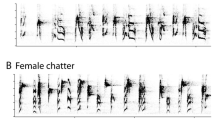Summary
Two song types were described for the Cuban Grassquit,Tiaris canora. A short song characterized by buzzy and harmonic rich syllables increased in the presence of males and was probably primarily aggressive in function. A second, longer song type, characterized by many pure-toned syllables, increased in the presence of females and was probably sexual in function. Pairs also participated in duet singing against territorial rivals, or as greeting ceremonies between mates after a period of separation.
Duetting in Cuban Grassquits probably functions in maintenance of the pair bond. Comparisons were made with other avian species having different song types serving different functions.
Zusammenfassung
Das Männchen des Kleinen Kubafinken (Tiaris canora) verfügt über zwei verschiedene Gesangsformen: Einen kurzen Gesang mit summenden, harmonischen und vollen Tönen, dessen Häufigkeit bei Anwesenheit anderer ♂ ♂ zunimmt und der wahrscheinlich in erster Linie eine aggressive Funktion erfüllt; und einen längeren Gesangstyp mit vielen aus reinen Tönen zusammengesetzten Silben, dessen Häufigkeit bei Anwesentheit von ♀ zunimmt und dem offenbar eine sexuelle Funktion zukommt. Duettgesänge zwischen den Partnern eines Paares werden sowohl gegenüber Rivalen als auch als Begrüßungszeremonie nach einer Zeit der Trennung vorgetragen. Sie dienen wahrscheinlich dem Festigen des Paarzusammenhaltes.
In der abschließenden Diskussion werden die Befunde an Kubafinken mit denen an anderen Vogelarten verglichen, die ebenfalls über verschiedene Gesänge mit unterschiedlichen Funktionen verfügen.
Similar content being viewed by others
Literature
Andrew, R. J. (1961): The displays given by passerines in courtship and reproductive fighting: a review. Ibis 103 a: 315–348, 549–579.
Armstrong, E. A. (1963): A study of birdsong. Oxford Univ. Press. London.
Baptista, L. F. (1972): Wild house finch sings White-crowned Sparrow song. Z. Tierpsychol. 30: 266–270.
Ders. (1975): Song dialects and demes in sedentary populations of the White-crowned Sparrow (Zonotrichia leucophrys nuttalli). Univ. Calif. Publ. Zool. 105: 1–52.
Ders. (1976): Handedness, holding and its possible taxonomic significance in Grassquits (Tiaris). Ibis 118: 218–222.
Bastock, M. (1967): Courtship, an ethological study. Aldine Publ. Co. Chicago.
Becker, P. H. (1974): Der Gesang von Winter- und Sommergoldhähnchen (Regulus regulus, R. ignicapillus) am westlichen Bodensee. Vogelwarte 27: 233–243.
Bond, J. (1971): Birds of the West Indies. Houghton Mifflin. Boston.
Butler, A. G. (1899): Foreign finches in captivity. Second Edition. Brumby and Clarke, Ltd. London.
Catchpole, C. K. (1973): The functions of advertising song in the Sedge Warbler )Acrocephalus schoenobaenus) and the Reed Warbler (A. scirpaceus). Behaviour 46: 300–320).
Emlen, S. T. (1972): An experimental analysis of the parameters of bird song eliciting species recognition. Behaviour 41: 130–170.
Goodwin, R. (1959): Breeding of the Black-faced Grassquit,Tiaras bicolor, in captivity and some notes on the comparitive behaviour of the genus. Avicult. Mag. 65: 131–134.
Harrison, C. J. O. (1962): Solitary song and its inhibition in some Estrildidae. J. Orn. 103: 369–379.
Immelmann, K. (1969): Song development in the zebra finch and other estrildid finches. In: Bird Vocalizations.R. A. Hinde, Ed. Cambridge Univ. Press.
Ders. &G. Immelmann (1967): Verhaltensökologische Studien an afrikanischen und australischen Estrildiden. Zool. Jb. Syst. 94: 609–686.
Kern, M. D. &J. R. King (1972): Testosterone-induced singing in female White-crowned Sparrows. Condor 74: 204–209.
Kunkel, P. (1974): Mating systems of tropical birds: the effects of weakness or absence of external reproduction-timing factors, with special reference to prolonged pair bonds. Z. Tierpsychol. 34: 265–307.
Lanyon, W. E. (1969): Vocal characters and avian systematics. In: Bird Vocalizations.R. A. Hinde, Ed. Cambridge Univ. Press.
Marler, P. &P. Mundinger (1971): Vocal learning in birds. In: Ontogeny of Vertebrate Behavior.H. Moltz, Ed. Academic Press, New York.
Marshall, J. T. (1964): Voice in communication and relationships among Brown Towhees. Condor 66: 345–356.
Michaelis, H. J. (1965): Über die Haltung von Kubafinken. Falke 12: 98–99.
Morris, D. (1956): The function and causation of courtship ceremonies. Fondation Singer-Polignac, Colloque Internat. sur L'Instinct (Paris, 1954).
Newton, I. (1972): Finches. Collins. London.
Nottebohm, F. (1969): The song of the chingolo,Zonotrichia capensis, in Argentina: description and evaluation of a system of dialects. Condor 71: 299–315.
Payne, R. B. (1971): Duetting and chorus singing in African birds. Ostrich, Supplement 9: 125–146.
Ders. (1973): Behavior, mimetic songs and song dialects, and relationships of the parasitic Indigobirds (Vidua) of Africa. A.O.U. Monograph, 11.
Poulson, H. (1954): On the song of the Linnet (Carduelis cannabina L.). Dansk. orn. Foren. Tidsskr. 48: 32–37.
Quaintance, C. W. (1938): Content, meaning and possible origin of male song in the Brown Towhee. Condor 40: 97–101.
Ridgway, R. (1901): Birds of North and Middle America, part 1, volume 2. Bull. U. S. Natl. Mus., 50.
Smith, R. L. (1959): The songs of the Grasshopper Sparrow. Wilson Bull. 71: 141–152.
Sparks, J. H. (1964): Contact behaviour in the Cuban Finch,Tiaris canora (Gmelin). Bull. Brit. Orn. Cl. 84: 164–169.
Thielcke, G. (1970 a): Vogelstimmen. Springer Verlag, New York.
Ders. (1970 b): Die sozialen Funktionen der Vogelstimmen. Die Vogelwarte 25: 204–229.
Ders. &H. Thielcke (1970): Die sozialen Funktionen verschiedener Gesangsformen des Sonnenvogels (Leiothrix lutea). Z. Tierpsychol. 27: 177–185.
Shiovitz, K. A. (1975): The process of species-specific song recognition by the Indigo Bunting,Passerina cyanea, and its relationship to the organization of avian acoustical behavior. Behaviour 55: 128–179.
Thompson, W. L. (1960): Agonistic behavior in the House Finch. Part I: Annual cycle and display patterns. Condor 62: 245–271.
Thorpe, W. H. (1964): Singing. In: A new dictionary of birds.A. L. Thompson, Ed. McGraw-Hill, New York.
Wolf, L. L. (1977): Species relationships in the Avian GenusAimophila. A.O.U. Monograph No. 23.
Author information
Authors and Affiliations
Rights and permissions
About this article
Cite this article
Baptista, L.F. Territorial, courtship and duet songs of the Cuban Grassquit (Tiaris canora). J Ornithol 119, 91–101 (1978). https://doi.org/10.1007/BF01642973
Published:
Issue Date:
DOI: https://doi.org/10.1007/BF01642973




